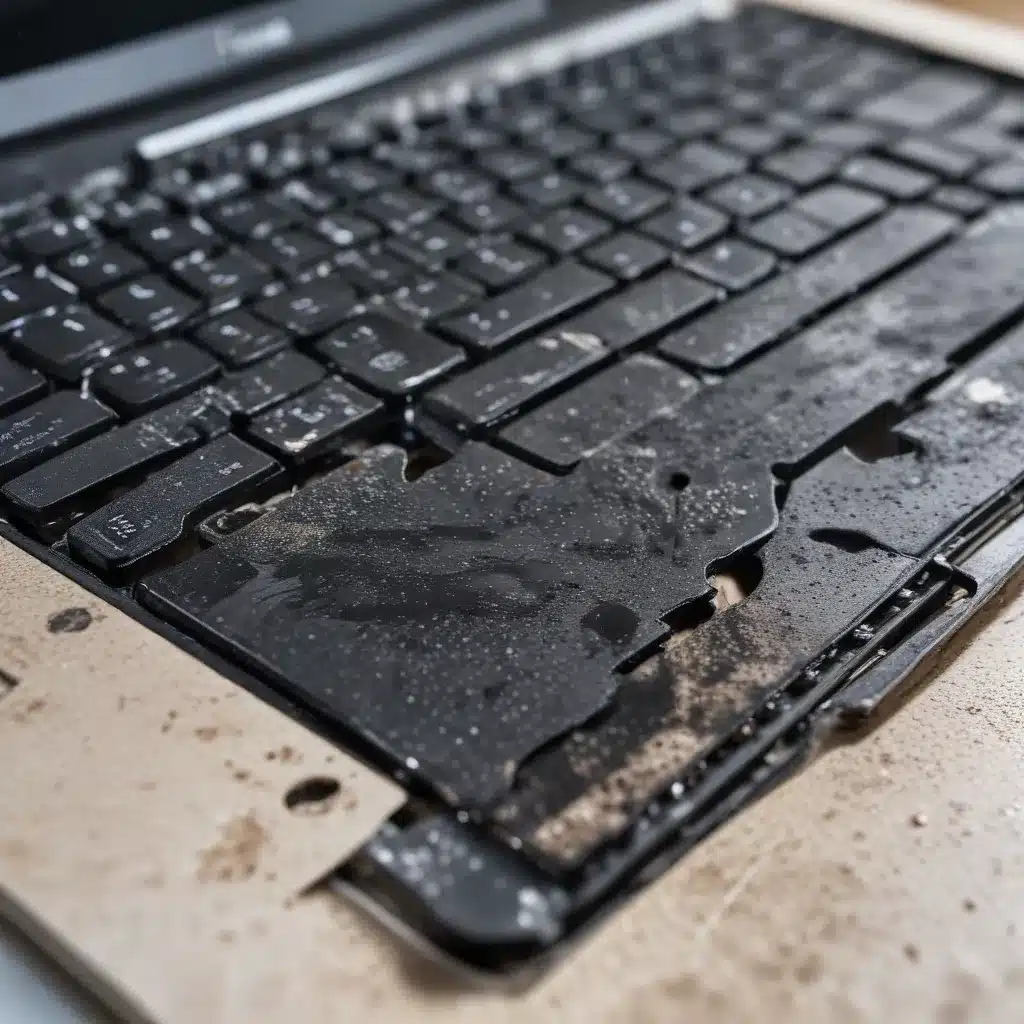
Computer Hardware
Desktop Computers
Desktop computers, with their robust and modular design, can often withstand minor water exposure better than their laptop counterparts. The key components, such as the motherboard, power supply, and storage drives, are typically housed in a sturdy metal or plastic casing, providing some level of protection against liquid ingress.
Laptop Computers
Laptops, on the other hand, are more susceptible to water damage due to their compact and integrated construction. The sensitive electronic components are packed tightly together, making it more challenging to isolate and dry out affected areas. Additionally, the delicate nature of laptop parts, such as the display, keyboard, and internal connectors, can lead to costly repairs or even complete system failure if exposed to water.
Computer Components
Common computer components that can be affected by water damage include the motherboard, processor, memory modules, storage drives (HDD, SSD), graphics card, and power supply. The extent of the damage will depend on the duration and amount of water exposure, as well as the specific design and protective measures built into the individual components.
Water Damage in Electronics
Causes of Water Damage
Water damage in computers can occur due to a variety of reasons, such as accidental spills, leaks from nearby plumbing, or environmental factors like flooding. In some cases, even high humidity levels can lead to condensation buildup and potential water-related issues.
Effects of Water Damage
The primary concern with water damage in computers is the risk of short circuits, corrosion, and component failure. When water comes into contact with the delicate electronic circuitry, it can create conductive pathways that can lead to electrical shorts, data loss, and permanent damage to the affected components.
Identifying Water Damage
Signs of water damage in a computer may include:
– Discoloration or staining of internal components
– Visible water droplets or condensation
– Unusual noises or erratic behavior from the system
– Failure to power on or boot up correctly
– Unresponsive or malfunctioning components
Repair Procedures
Disassembly
The first step in repairing a water-damaged computer is to carefully disassemble the device, exposing the internal components. This process requires a set of specialized tools, such as precision screwdrivers, and should be performed in a clean, well-lit work area to avoid further contamination.
Drying Techniques
Once the computer is disassembled, the affected components must be thoroughly dried. This can be accomplished using a variety of methods, including:
– Absorbing excess moisture with a clean, lint-free cloth or paper towels
– Using a can of compressed air to gently blow away any remaining water droplets
– Placing the components in a well-ventilated area or using a low-heat drying method, such as a fan or dehumidifier
Replacement Parts
Depending on the extent of the damage, some components may need to be replaced entirely. Common replacement parts for water-damaged computers include:
– Motherboard
– Processor
– Memory modules
– Storage drives (HDD, SSD)
– Power supply
– Cooling fans
Preventative Measures
Spill-Proofing Devices
To minimize the risk of water damage, consider investing in spill-proof or water-resistant computer cases, keyboards, and other accessories. These products often feature sealed or raised edges to help contain any accidental spills.
Protective Accessories
Utilizing protective accessories, such as laptop sleeves, waterproof keyboard covers, or waterproof mouse pads, can also help safeguard your devices from unexpected liquid exposure.
Backup and Data Recovery
Regularly backing up your data to an external storage device or cloud-based service is crucial in the event of water damage. This will ensure that your important files, documents, and other digital assets are protected and can be easily restored.
Troubleshooting Water Damage
Diagnostic Processes
When troubleshooting a water-damaged computer, it’s essential to methodically work through the diagnostic process. This may involve testing individual components, checking for corrosion, and carefully inspecting the device for any signs of water intrusion.
Common Issues
Some of the most common issues encountered with water-damaged computers include:
– Power supply failure
– Motherboard and component malfunctions
– Data corruption or loss
– Intermittent or complete system failure
Contacting Repair Services
If the extent of the water damage is significant or you feel uncomfortable attempting the repair yourself, it’s best to consult with a professional computer repair service. These experts have the necessary tools, expertise, and resources to properly diagnose and address the issue, minimizing the risk of further damage.
Electronic Cleaning Techniques
Cleaning Agents
When cleaning water-damaged computer components, it’s important to use the appropriate cleaning agents. Isopropyl alcohol (IPA) is a common choice, as it effectively dissolves and removes contaminants without leaving behind residue.
Cleaning Methods
Carefully wiping down the affected components with a clean, lint-free cloth dampened with IPA can help remove any remaining moisture or corrosive deposits. In some cases, a soft-bristle brush may be used to gently dislodge any stubborn debris.
Safety Considerations
Always exercise caution when working with electronic components and cleaning agents. Ensure the work area is well-ventilated, and avoid prolonged skin contact or inhalation of the cleaning solutions.
Data Recovery Strategies
Data Backup Solutions
Regularly backing up your data to an external storage device or cloud-based service is crucial in the event of water damage. This will ensure that your important files, documents, and other digital assets are protected and can be easily restored.
Data Restoration Procedures
If your computer’s storage drive has been affected by water damage, attempting to recover the data yourself may be possible, but it requires a delicate and meticulous approach. In more severe cases, it’s best to seek the assistance of professional data recovery services.
Professional Data Recovery Services
Specialized data recovery companies have the equipment, expertise, and clean-room facilities to safely extract data from damaged storage drives, often with a higher success rate than DIY attempts.
Electrical Safety Protocols
Electrical Hazards
When dealing with water-damaged electronics, it’s crucial to be mindful of electrical hazards. Ensure that the device is completely powered off and unplugged before attempting any repairs or cleaning.
Grounding and Isolation
Proper grounding and electrical isolation techniques are essential to prevent static discharge and further damage to the components. Use anti-static mats, wrist straps, and other grounding accessories when working on water-damaged electronics.
Power Supply Handling
Exercise caution when handling the power supply unit, as it can retain a dangerous electrical charge even when the device is powered off. Discharge any remaining voltage before attempting to inspect or replace the power supply.
Warranty and Insurance Claims
Manufacturer Warranties
Depending on the age and condition of the affected device, the manufacturer’s warranty may cover the cost of repairs or replacement. Be sure to review the warranty terms and follow the proper claim submission process.
Third-Party Insurance
Homeowner’s or renter’s insurance policies may also provide coverage for water damage to electronic devices. Investigate your policy details and follow the necessary steps to file a successful claim.
Claim Submission Process
When submitting a warranty or insurance claim, be prepared to provide detailed documentation, including photographs of the damaged components and a thorough description of the incident. This will help expedite the review and approval process.
Environmental Impact of Water Damage
E-Waste Disposal
In cases where the water damage is too extensive and the affected components cannot be salvaged, it’s important to properly dispose of the e-waste in an environmentally responsible manner. Consult with local authorities or recycling centers to ensure the components are handled and disposed of correctly.
Sustainable Repair Options
Whenever possible, prioritize repairing and refurbishing water-damaged computers over replacing them entirely. This not only saves money but also reduces the environmental impact of e-waste.
Energy-Efficient Replacements
If a complete system replacement is necessary, consider upgrading to newer, more energy-efficient models that can help reduce your carbon footprint and long-term energy costs.
Industry Regulations and Standards
Water Damage Certification
Some computer repair technicians and service centers may hold certifications or specialized training in water damage restoration, ensuring they follow industry best practices and adhere to relevant regulations.
Repair Best Practices
Reputable computer repair providers should follow established industry standards and guidelines when addressing water-damaged devices, prioritizing safety, data protection, and effective restoration methods.
Legal Compliance
Depending on your location, there may be local laws and regulations governing the handling, disposal, and recycling of water-damaged electronic equipment. Be sure to familiarize yourself with the relevant requirements in your area.
Laptop-Specific Repair Considerations
Fragile Components
Laptops often have more delicate and tightly-packed components compared to desktop computers, making the repair process more challenging. Particular care must be taken when disassembling and handling laptop parts to avoid further damage.
Specialized Tools
Repairing water-damaged laptops may require specialized tools, such as precision screwdrivers, tweezers, and anti-static mats, to safely access and work on the internal components.
Reassembly Techniques
Properly reassembling a water-damaged laptop is crucial, as any misaligned or loose components can lead to ongoing issues. Follow the manufacturer’s guidelines or seek the assistance of a professional repair service to ensure a successful reassembly.
Remember, while water damage can be a significant challenge, with the right approach and attention to detail, it is often possible to salvage and repair water-damaged computers. By following the recommended procedures, exercising caution, and seeking professional help when needed, you can increase the chances of restoring your device to full functionality.












